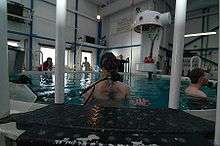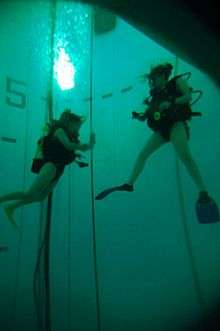Submarine escape training facility
A Submarine Escape Training Tower is part of a facility used for training submariners in methods of emergency escape from a disabled submarine. It is a tall cylinder filled with water with several entrances at varying depths each simulating an airlock in a submarine. Since the 1930s, towers have been built for use by the Royal Navy, US Navy, Royal Australian Navy and in several other countries.

Royal Navy SETT


The Submarine Escape Training Tank (SETT) is a 100-foot (30 m) deep facility primarily operated to conduct training with submarine escape equipment, operated by the Royal Navy.[1][2] The facility, located at Fort Blockhouse, Gosport opposite HMNB Portsmouth,[3] includes a fresh, chlorinated water column with a single escape chamber (as fitted to some classes of RN submarines) mounted at the base, through which students can conduct a fully representative escape cycle from 100 feet (30 m), closely replicating actions which would be required if forced to abandon a distressed submarine from depth. The SETT has its own dedicated boiler house to maintain its water temperature at 34 °C (94 °F).[3] The SETT was commissioned in 1954, with the first students trained in July of that year. Since that time completion of ‘the Tank’ has been a rite of passage for all RN Submariners. Training includes ascents from increasing depths as a major element, but in addition is underpinned by lectures and practical training in how to survive within a disabled submarine, operation of emergency equipment and survival techniques on reaching the surface – a package of potentially life saving skills. Over the years, the SETT has been used to train submariners from Italy, USA, Greece, Canada, Israel, Russia, Venezuela, Turkey, Australia and the Netherlands – with the staff and facility enjoying a worldwide reputation for excellence and good practice.[4] Owing to a combination of increased safety associated with modern submarine design, submarines operating in areas where escape would be impossible with current equipment and the risk associated with the conduct of training, the RN discontinued pressurised submarine escape training in March 2009.
The staff at RNSETT are drawn from the ranks of the UK Submarine Service. All members of SETT staff form part of the SMERAT (Submarine Escape and Rescue Advisory Team),[5] some members form the UK SPAG (Submarine Parachute Assistance Group),[6] and some form part of the UK contribution to the NSRS (LR5) Team.[7] All staff are trained in advanced life-saving techniques and diving medicine.
Other uses
The tower was also privately hired to civilian diving clubs for the purpose of recreational diving and dive training. It was a popular 'novelty' dive amongst UK SCUBA divers since it allowed new trainees to extend their depth experience in a safe, controlled environment with good visibility and warm water temperature – two conditions that are in short supply in the UK. For similar reasons it was also used for freediving training, with participants including world record-holder Tanya Streeter.[8] In addition, the SETT has been used frequently for both underwater equipment testing, and to support media activity – notably hosting Blue Peter on a number of occasions, with some presenters completing ascent training. It has also been used frequently as a Situation Assessment Trials Tank (SATT) for Technical Divers.
Other facilities
US Navy escape towers were known as Escape Training Tanks. From the 1930s through the 1990s they were used for training in buoyant ascent, the Momsen lung, and the Steinke hood. The decommissioned tower on Ford Island, Hawaii, was built to train United States Navy Pacific Fleet submariners prior to World War II, and was converted for use as an airport control tower after the attack on Pearl Harbor.[9] Across the harbor, the tower on Sub-Base Pearl Harbor was used between 1932 and 1983. Neither of the U.S. escape towers in Hawaii are in use. The towers were also used to train SCUBA equipped divers (SEALs) or Underwater Demolition Teams to access or egress the submarine during Special Operations. The tower once located on Naval Submarine Base New London was in use between 1930 and 1994 and has since been razed. The Submarine Escape Trainer, a 40-foot (12 m) high, 84,000-gallon pool with two escape trunks was constructed at New London in 2007.[10]
Similar facilities are operated by the Royal Australian Navy at the Submarine Escape Training Facility at HMAS Stirling,[11] and in Norway, Sweden and Turkey at Gölcük Naval Base.[12] The German Navy operates a 36-metre-deep escape training pool, built in 1977, at Einsatzausbildungszentrum Schadensabwehr Marine (Damage Control Training Centre) in Neustadt in Holstein.[13]
References
- Elliott, D (1999). "A short history of submarine escape: The development of an extreme air dive". South Pacific Underwater Medicine Society Journal. 29 (2). ISSN 0813-1988. OCLC 16986801. Retrieved 2008-06-19.
- House CM, House JR, Oakley EH (2000). "Findings from a simulated disabled submarine survival trial". Undersea and Hyperbaric Medicine. 27 (4): 175–83. PMID 11419357. Retrieved 2008-06-19.
- "Submarine Escape Training Tank". Royal Navy. Archived from the original on 31 May 2009. Retrieved 2009-06-22.
- Callow, Ian (2006). "Submarine Escape Training". Retrieved 20 January 2011.
- "ATP-57" (PDF). NATO. Retrieved 2011-04-01.
- "Submarine Parachute Assistance Group (SPAG)". Royal Navy. Retrieved 2011-03-29.
- "NATO Submarine Rescue System". Royal Navy. Retrieved 2011-04-01.
- Farrell, Emma (2006) One Breath: A Reflection on Freediving, photographs by Frederic Buyle, Pynto Ltd., Hatherley, UK: ISBN 0-9542315-2-X
- Cole, William (2005-12-06). "Ford Island museum will focus on attack". Honolulu Advertiser. Retrieved 2009-09-06.
- Howland, Robert (2 November 2007). "Construction Complete on Unique Submarine Escape Trainer at SUBASE New London". United States Navy. Retrieved 21 April 2011.
- Davidson, Jon; Allibone, Tom (2005). Beneath Southern Seas. Crawley, WA: University of Western Australia Press. pp. 165–9. ISBN 1-920694-62-5. OCLC 69242056.
- "Submarine Escape Training Tank". Turkish Navy. Retrieved 22 April 2011.
- "Tauchtopf". German Navy. Retrieved 28 April 2011.
External links
| Wikimedia Commons has media related to Submarine escape training facilities. |
- Rescue Tank May End Sub Deaths, November 1930, Popular Science – two-page 1930 article on the new US Navy SETT in New London, Connecticut
- Royal Navy Submarine School (RNSMS)
- Submarine Escape Training Tank – Royal Navy website
- International Submarine Escape & Rescue Office
- UK-International Submarine Escape & Rescue Training
- Horsea Island Dive Centre website